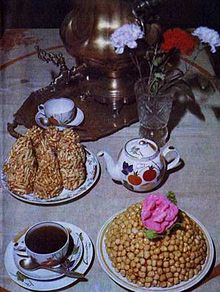Tatar Cuisine
Tatar Cuisine
Tatar culinary traditions were formed centuries ago. Preserving its authentic nature, Tatar cuisine used to adopt the trends of the neighboring empires. Qatiq (fermented milk), bal mai (honey butter), and kabartma (flatbreads) are Turkic legacy; pelmeni and tea came from China; pilaf, halva, and sherbet are Uzbek dishes; baklava is a Tajik highlight. Besides, the experience of Tatar chefs used to be greatly valued as well. The Tatars taught Russian chefs to fry foods. Even during the rule of Ivan the Terrible, the Tatars were the only source of fried foods, as Russian cuisine was limited to boiling and baking. The fact that Tatars had been leading a life of sedentary cattle breeders determined the tradition of adding flour, meat, and dairy products to nearly all foods. Mutton has been considered the most favored Tatar meat dish, though it is not as popular as it is with Kazakh and Uzbek people. Beef and poultry (chicken, goose, and duck) have always been quite popular. Early recipes include cooking, salting, and wrapping meat to get kazylyk sausage. The kyzdyrma recipe has remained unchanged. It is made of horsemeat, beef, sometimes mutton or goose. You remove all bones, cut the meat into large pieces, add salt and pepper, and leave it in a cold place for 3 hours. Then you fry the meat pieces in a small amount of oil, put them into a jar, add melted or drawn butter, and keep in a cold place. People prefer to cook very large amounts of kyzdyrma. It is a convenient travel food often consumed cold.
Tatar cuisine is marked by certain taboos. It is a common fact that pork as well as hawk and swan meat (the latter birds are considered sacred) must not be eaten under the Sharia Law. Most importantly, wine and other spirits are prohibited. The Quran says wine and gambling to be both good and bad, but it does specify that the latter quality dominate.
Tatar cuisine includes numerous dairy products. Unskimmed milk was only used to feed babies or added to tea, while adults preferred fermented milk products. Fermented milk was boiled to prepare qatiq. Its mixture with cold water made ayran, which is a very refreshing drink. Qatiq was also used to cook one of the kinds of Tatar cheese – suzme (syuzme). You put qatiq in a sack and let it hang down till the whey runs off. Eremlekti cheese was made by fermenting milk while boiling it and cooking the cheese slowly till dense. If you keep cooking it till all the whey evaporates, you get a reddish brown porous substance called qurut, or Tatar cottage cheese. Qurut was traditionally mixed with butter (fatty qurut), boiled with honey, and served with tea. Sometimes people just strained the cream off o cook it and get the delicious peshe kaymak. Meat and milk-based soups and broths (shurpa, ash) as well as soups and broth without the components are characteristic of Tatar cuisine. Their names contain the names of the main ingredients; cereals, vegetable dishes, and pastry included tokmach, umach, chumar, and salma-attar. Tokmach noodles is mostly made of flour-and-egg mixture. Umachty is round-shaped noodles or oblong pieces of thoroughly kneaded dough containing some pea flour. Pea, buckwheat, lentil, and wheat flour was used for making noodles. The dough was cut into large strips. The strips were either cut with a knife or torn manually. Each peace was the size of a hazelnut. You pressed its center with your thumb, thus shaping each “nut” to resemble an ear. To cook chumar, you need a softer dough cut or torn into large pieces which you put into broth. The tradition of serving pelmeni in broth (pelmeni kiyau) came from China. Sweet buns made of unfermented, yeast bread made with butter, or milk is a Tatar highlight. Ikmek bread symbolized prosperity and wellness. In old times, Tatar people used to bake lots of it two or three times a week. One of the oldest dishes is kystybyi (kuzimyak) – barley-filled flatbread. Belesh-belyash (belish) is also an ancient dish, which is cooked of unfermented, yeast dough filled with fatty meat (mutton, beef, or goose), or potato slices. Small pies were called vak belesh. Peremyachi is another pastry made of unfermented or yeast dough baked with various delicious fillings. Peremyachi can be shaped as crust or potpies. It is either deep-fried or roasted in a closed pot in an oven. Bekkender (bukerler) was also cooked of unfermented or yeast dough, mostly with fruit and vegetables (carrots, beetroot), but barley, rice, and pumpkin pies are especially popular. A high multilayer gubadiya pie is the highlight of a festive meal. It necessarily contains qurut, red dried cottage cheese. The pie is traditionally served before the dessert. Liquid yeat dough is used to cook koymak (kaymak, kaymag), pancakes prepared on ho coal. They are traditionally served with melted butter for breakfast and on religious holidays (gayet). Dense dough was used to cook kabartma and yuka (thin noodles made of unfermented dough made with milk and butter), baursaks, deep fried small dough balls, yuacha, and small round bread. Now we should mentioned foods served specifically with tea, which are mostly made of sweet butter-and-milk dough –shelpek, katlama, kosh-tele (bird’s tongue), kakly, katly pashtetter (pocket pie and open pie), and of course chak-chak. Chak-chak is small pieces of sweet butter-and-milk dough covered with honey, sometimes also with nuts. It is another highlight of traditional Tatar cuisine. Nowadays, it is often served as a special dish at wedding ceremonies and parties. The diversity and unique taste of Tatar cuisine is present at every sabantuy celebration meal. The fest is meant to celebrate prosperity and welfare.
References: Traditions and Customs of Ethnic Groups within Kazakhstan. – Almaty, 2006.
 Қысқа да нұсқа. Жазылыңыз telegram - ға
Қысқа да нұсқа. Жазылыңыз telegram - ға